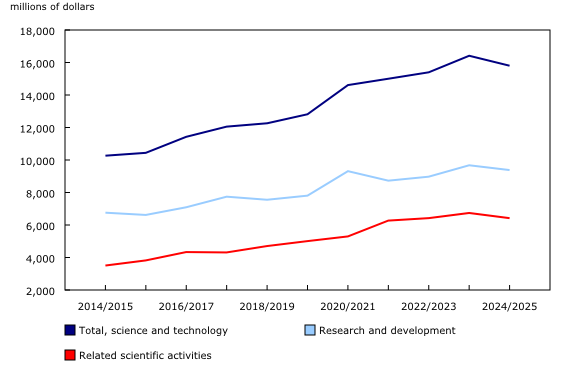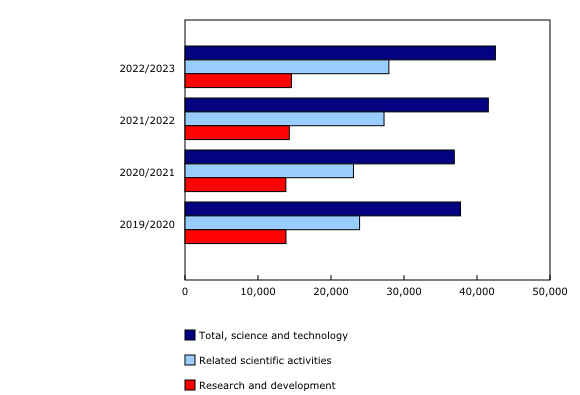Federal Science and Technology Expenditures and Personnel, 2022/2023 (actual), 2023/2024 (preliminary), and 2024/2025 (intentions)
Released: 2024-06-27
$15.8 billion
2024/2025
-3.7% 
(annual change)
In 2022/2023, federal government science and technology (S&T) spending rose $396 million to $15.4 billion, following a $391 million gain in 2021/2022 ($15.0 billion).
Preliminary estimates show that federal S&T expenditures will increase to $16.4 billion (+$1.0 billion) in 2023/2024 due to higher research and development (R&D) spending (+$702 million to $9.7 billion). These expenditures would surpass the previous high of $9.3 billion spent on R&D in 2020/2021.
Federal S&T expenditures in 2024/2025 are expected to decline $613 million to $15.8 billion.
The federal government facilitates science and technology activities
The federal government plays an important part in fostering R&D in Canada as both a performer and funder of S&T programs. As a performer, it facilitates S&T activities through its departments, which are often guided through federal fiscal budgets, as well as the agencies, commissions, boards, and crown corporations that it regulates. Some of the key areas of interest include public health, environmental sustainability, technology and national security.
As a funder, the federal government provides S&T funding to various sectors, such as businesses and higher education institutions, through grants and contracts to support innovation and help businesses remain competitive.
Science and technology expenditures have increased for eight consecutive years
The federal government's increased S&T spending in 2022/2023 marks the eighth consecutive year-over-year growth and was due to increased spending in both core activities: R&D (+$245 million to $9.0 billion) and related scientific activities (RSA; +$151 million to $6.4 billion).
R&D and RSA are conceptually similar, though there are notable differences between the two. At the heart of R&D is systematic work aimed at developing new products and services. Meanwhile, RSA activities are generally viewed as complementing or supporting R&D—focusing more on actions related to data collection, special surveys, and studies—and are not generally considered as R&D spending based on the international Frascati Manual standard.
S&T expenditures can also be broken down into two fields of research: the natural sciences and engineering, which focuses on disciplines associated with the natural world; and social sciences, humanities and the arts, which focuses on phenomena affecting humans. Both fields had similar growth (in dollar terms) in 2022/2023 (+$206 million to $11.8 billion for the natural sciences, and +$191 million to $3.6 billion for the social sciences), though most of the spending remained in the natural sciences and engineering field (76.7%).
Regionally, the growth in S&T expenditures in 2022/2023 was concentrated in Ontario excluding the National Capital Region (NCR; +$331 million to $3.7 billion), followed by British Columbia (+$96 million to $1.6 billion) and Manitoba (+$91 million to $477 million).
Both intramural and extramural science and technology spending increase
Intramural S&T spending within the federal sector rose $233 million to $6.4 billion in 2022/2023. This increase was larger than the gain in extramural spending, which was up $164 million to $9.0 billion.
The growth in extramural spending was mainly attributable to increased funding for Canadian non-profit institutions (+$203 million to $1.2 billion), followed by funding for provincial and municipal governments (+$56 million to $299 million).
These increases were partially offset by decreased funding for the foreign sector (-$56 million to $1.2 billion). The higher education (-$28 million to $4.2 billion) and the business enterprise (-$12 million to $2.1 billion) sectors also saw a decrease in funding, though both remained the largest recipients of overall funding.
Science and technology expenditures by major departments and agencies
Among the 16 major federal S&T departments and agencies (organizations whose S&T spending was equal to or exceeded 2% of the total S&T expenditures by the federal government in 2022/2023), 12 departments increased their spending (+$492 million) in 2022/2023 while 4 departments decreased their spending (-$321 million).
The overall increase in S&T expenditures was led by the Canadian Space Agency (+$126 million to $456 million), followed by Environment and Climate Change Canada (+$60 million to $996 million) and the Public Health Agency of Canada (+$52 million to $436 million).
The rise in intramural spending within the federal government itself was led by the Public Health Agency of Canada (+$106 million), while the increase in extramural payments was driven by the Canadian Space Agency (+$111 million) and Environment and Climate Change Canada (+$82 million).
Science and technology personnel increases on the strength of related scientific activities
Following record growth in personnel in 2021/2022, the number of full-time equivalents (FTEs) working in S&T rose again in 2022/2023 (+970 FTEs, reaching 42,520 FTEs) as a result of increased RSA personnel (+664 to 27,930), specifically in the scientific and professional occupational category (+1,750 to 18,285).
From a regional perspective, the largest increase in FTEs occurred in the NCR (+615 FTEs to 26,152 FTEs), followed by Manitoba (+208 to 1,816), Ontario excluding the NCR (+107 to 2,841) and Quebec excluding the NCR (+104 to 4,283).
Did you know we have a mobile app?
Download our mobile app and get timely access to data at your fingertips! The StatsCAN app is available for free on the App Store and on Google Play.
Note to readers
Federal Science Expenditures and Personnel, Activities in the Social Sciences and Natural Sciences is an annual survey of all federal government departments and agencies that perform or fund science and technology activities. Actual data for 2022/2023, preliminary data for 2023/2024 and intentions for 2024/2025 were collected from September to December 2023, based on the federal government's fiscal year running from April 1 to March 31.
Science and technology activities comprise two types of scientific activities: research and development (R&D), and related scientific activities (RSA). They can be defined as all systematic activities that are directly related to the generation, advancement, dissemination and application of scientific and technical knowledge in all fields of science and technology.
Research and development (R&D) comprise creative and systematic work done to increase the stock of knowledge—including knowledge of humankind, culture and society—and to devise new applications of available knowledge. R&D activities must satisfy all five of the following core criteria:
1. They are aimed at new findings (novel).
2. They are based on original, not obvious, concepts and hypotheses (creative).
3. They are uncertain about the final outcome (uncertainty).
4. They are planned and budgeted (systematic).
5. They lead to results that could be possibly reproduced (transferable/or reproducible).
Related scientific activities (RSA) are all systematic activities directly related to the generation, advancement, dissemination and application of scientific and technological knowledge. RSA generally include general purpose data collection, which excludes the collection of data as part of an R&D project; information services (the collection, coding, analysis, evaluation, recording, classification, translation and dissemination of scientific and technological information); special surveys and studies (systematic investigations carried out to provide information needed for planning or policy formulation); education supports (grants to support the postsecondary education of students in the natural or social sciences and technology).
Natural sciences and engineering consist of all disciplines concerned with understanding, exploring, developing or using the natural world. Included are engineering, technology, mathematics, computer and information sciences, physical sciences, medical and health sciences, agricultural sciences, veterinary sciences, and forestry.
Social sciences, humanities and the arts consist of disciplines concerned with the study of human actions and conditions and the social, economic and institutional mechanisms that affect humans. Included are the arts, economics and business, education, history and archeology, law, languages and linguistics, media and communications, philosophy, ethics and religion, psychology and cognitive sciences, social and economic geography, and sociology.
The performer is equivalent to the sector in which the scientific activity is conducted. The basic distinction is between intramural and extramural performance.
Intramural (in-house) activities include all current expenditures incurred for scientific activities carried out by in-house personnel of units assigned to the program.
Extramural (outsourced) activities include all expenditures incurred by the federal government's agencies and departments for scientific activities carried out by the five following performers: business enterprises, higher education, Canadian non-profit institutions, provincial and municipal governments and foreign performers.
Full-time equivalent is the personnel expressed as a ratio of working hours actually spent on scientific activities during a specific reference period divided by the total number of hours conventionally worked in the same period by an individual or a group. For example, an employee who is engaged in scientific activities for half a year has a full-time equivalence of 0.5.
Scientific and professional personnel (also called researchers) are professionals engaged in the conception or creation of new knowledge. They conduct research and improve or develop concepts, models and methods. Managers and administrators who plan and manage the scientific and technical aspects of a researcher's work, as well as graduate students, are also included.
Technical personnel perform scientific and technical tasks involving the application of concepts and operational methods in one or more fields of the natural sciences and engineering, or of the social sciences, humanities and the arts, normally under the supervision of researchers.
Other personnel (also called support staff) includes skilled and unskilled workers, as well as administrative, secretarial and clerical staff directly associated with research and development projects.
The National Capital Region comprises Ottawa (Ontario) and the neighbouring city of Gatineau (Quebec).
More information on the concepts and definitions of the survey (4212) is available from this release's Related information tab.
To better understand the concepts outlined in this survey, please consult the Frascati Manual 2015: Guidelines for Collecting and Reporting Data on Research and Experimental Development, The Measurement of Scientific, Technological and Innovation Activities, OECD Publishing, Paris.
Contact information
For more information, or to enquire about the concepts, methods or data quality of this release, contact us (toll-free 1-800-263-1136; 514-283-8300; infostats@statcan.gc.ca) or Media Relations (statcan.mediahotline-ligneinfomedias.statcan@statcan.gc.ca).
- Date modified:


